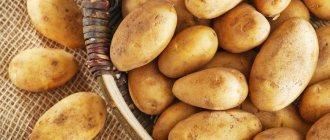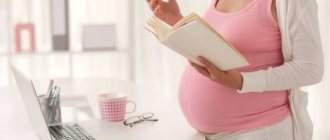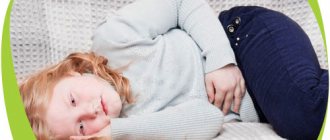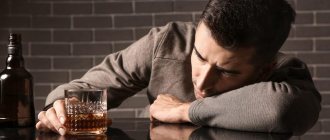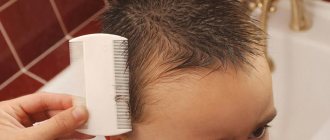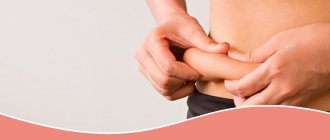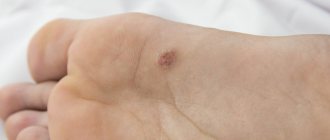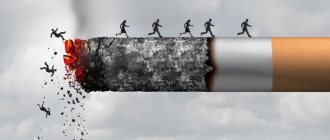What causes lice
Despite popular belief, lice do not only affect people who do not maintain personal hygiene or lead an antisocial lifestyle. It is much easier to catch parasites than to remove lice. They easily transfer to the scalp and hair when using personal items, bedding, or simply from another person. Insects move quite quickly and can remain outside the human body for some time. They even survive in water or at high air temperatures, so you can become infected with them, for example, in a pool, sauna or on the beach. Very often, lice are picked up in crowded places - in transport, hospitals, children's institutions. There is no guarantee of protection from this scourge. Everyone is at risk of becoming infected.
Benefits of Combing
Combing is one of the most popular methods because it has several advantages:
- The method is suitable for people of any age;
- The use of combs and combs cannot provoke an allergic reaction;
- The negative effects of chemicals on hair, scalp and the body as a whole are excluded;
- There is no risk of chemical burns;
- The comb can be used at any frequency;
- The shelf life of such a device is practically unlimited; it can be used even after several years.
But it is possible to remove lice in this way only if you have a special comb and follow all the rules, as well as carefully treat the hair. The comb can also be used for preventive purposes by combing your hair with it once a week.
What happens if you don't remove lice?
The main symptom, sign and unpleasant factor when infected with lice is severe itching. It is impossible to live in peace when your head is constantly itching. Therefore, they try to remove lice as quickly as possible. However, in some cases, people do not pay attention to the itching. This may be due to decreased sensitivity of the scalp or other reasons. Some may feel that their itchy scalp is due to an allergy to shampoo, water, or hats. If itching does not interfere with your life, you should pay attention to other symptoms of lice infestation:
- the appearance of insects - they can be seen with the naked eye, since the female’s body length reaches 0.4 mm, insects move along the hair, so with a certain amount of observation they can be noticed; if the hair is thick, you can comb it - when combing, you can find parasites;
- the presence of nits - lice eggs: these are very small white balls at the roots of the hair, with a large accumulation they are visible;
- bloody bite marks - when piercing the skin, the louse injects a substance into the skin that prevents the blood from clotting, so that a drop of blood flows out and remains on the surface; tangled and glued hair that forms mats: they stick together due to waste products of lice;
- with severe damage and a large number of parasites, an unpleasant odor emanates from the hair.
If you do not remove lice, you can get the following complicated consequences of lice:
- severe scratching at the site of bites;
- allergic reactions;
- infection of scratched wounds;
- through wounds, the infection enters not only under the skin, but also into the blood, which is why it spreads throughout the body; in advanced cases, this can lead to dangerous diseases and even blood poisoning.
It's sad, but some parents believe that head lice in a child does not require treatment or is not treated at all. For children's health, infestation with lice and nits is especially harmful, since the psyche also suffers: the child becomes restless and irritable from constant discomfort. It is necessary to remove lice from everyone - both children and adults.
Is it possible to get rid of lice in other ways?
There are other preparations for lice, for example, tar or dust soap. And you should soap your hair, wrap it in cellophane and leave for 15-12 minutes, then rinse well and remove nits by hand. The disadvantage of this product is the unpleasant odor.
Turpentine ointment also helps get rid of lice. However, you need to be prepared for increased oiliness in your hair after treatment. Kerosene is far from the best option, since it is a flammable liquid that has a negative effect on the hair and can cause a chemical burn.
To remove the parasite, you can use essential oils of tea tree, rosemary, lavender, wormwood, wild rosemary, and mint. They are added to hair masks or regular shampoo. Oils repel insects with their pungent odor, but do not completely remove them. Another thing is that periodic use of oils significantly reduces the risk of contracting lice.
Vinegar can break down the sticky substance, helping to get rid of nits. But it is ineffective against adult lice. To combat parasites, cherry water is used - a decoction or tincture of cherry. The composition should be applied to the hair and left for several hours. However, in this case, severe allergies cannot be ruled out, especially in children. You cannot use cherry water if there are wounds or scratches on the scalp.
Methods for getting rid of lice and nits
The fastest way to get rid of lice
The fastest way, which is not suitable for everyone, is to shave your head. Head lice move only on hair, and they also lay eggs only on hair. If there is no hair, then there are no lice. This method is the most effective. The head needs to be shaved, and then, to be on the safe side, you can wash it with anti-pediculosis shampoo to remove any remaining insects and nits that might remain between the skin scales. One such treatment is enough to get rid of lice forever. Care must be taken when processing. The cut hair must be carefully removed, and the room in which the shaving was done must be washed with insecticidal agents so that there are no living parasites and nits left in it. Lice live outside the human body for up to two days, and nits in a state of suspended animation for up to 10 days, after which, once in a favorable environment, they will live and develop further. To prevent this from happening, it is worth taking measures.
Folk remedies
Those with long hair will most likely not agree to get rid of it in order to cure lice. Traditional methods can also be used to remove lice and nits. Most often, folk remedies are used to remove lice from a child. It is believed that such time-tested methods are the most effective and safe.
Mechanical methods
To eliminate the use of any drugs altogether, you can use a comb. It is better to take a special comb with very fine teeth. Before treatment, be sure to cover your shoulders with a towel.
Methodology:
- Wash your hair with regular shampoo and treat only wet hair;
- secure them to the top of the head, separating them from the bun for processing one strand at a time;
- comb thoroughly along the entire length, starting from the very roots;
- after each combing, rinse the comb thoroughly under running water, washing away the adults and nits remaining on it;
- The combed strands are secured in a second, “clean” bun.
This method is suitable for people with not very long and not too thick hair and a slight lice infestation. The difficulty is that you can miss parasites. And if you leave at least one louse or nit in your hair, then in a week they will breed again. The procedure will have to be repeated several times to completely eliminate the presence of nits and adult individuals in the hair.
Kerosene
Attention! This method is considered proven, but it can cause a severe allergic reaction or burn. You need to act very carefully.
There is no need to apply pure kerosene to your hair. In order for it to linger on the head for effect, you need to prepare a mixture of a tablespoon of kerosene, two teaspoons of vegetable oil and a teaspoon of shampoo. For long and thick hair, double the amount of ingredients.
Apply this mixture to dry hair so that it saturates the hair to the roots. Put a plastic cap on the treated hair and wrap your head with a towel. The time required for exposure is 2 hours. For children, exposure time should not exceed 1 hour. After treatment, wash your hair with regular shampoo and rinse with a weak solution of vinegar. After washing, be sure to comb your still damp hair with a fine-tooth comb. After three days, this procedure must be repeated.
The disadvantage of this method, in addition to toxicity, is that in low concentrations kerosene may not kill nits, since they have a very dense shell. But in strong concentration it is dangerous to use it, and it is absolutely forbidden to treat children.
Vinegar
Please note! Vinegar rinsing is useless against adults. But it dissolves the substance with which nits are attached to the base of the hair. Therefore, a vinegar solution is supplemented with kerosene treatment.
The vinegar concentration should not exceed 9%. This is important to ensure safety and avoid burns. To rinse, part vinegar is dissolved in two parts water. For the best effect, the solution is applied to the hair, the head is wrapped in polyethylene and a towel, the mask is left on the hair for half an hour to an hour, after which the hair is thoroughly combed and washed off with shampoo. You can repeat the procedure for several days in a row, but you should not get carried away, as vinegar can change the color and structure of the hair and cause irritation of the scalp.
Herbs and other natural remedies
At home you can use the following products:
- hellebore water - suitable for treating thin and short hair, can be used to treat children, but it is important that there are no wounds on the skin, otherwise it will corrode them and cause an allergic reaction;
- washing your hair with regular shampoo, but with the addition of lavender, tea tree, eucalyptus oil, etc. - the use of essential oils with a pungent odor does not kill insects, but plays more of a preventive role, repelling them;
- rinsing with herbal decoctions (mint, wormwood, wild rosemary) or rubbing a paste of these herbs into the roots of the hair has a weak effect and can help with minor damage;
- a mask of crushed garlic or onion - use this method with caution, as irritation may occur on the scalp;
- wrap of cranberry juice or mint cranberries - in an acidic environment, insects can die, and their eggs will be better peeled off from the hair.
An unexpected and not very natural product that can be mentioned here is hair dye containing ammonia. If you dye her hair, the parasites will die. But it is worth remembering that not all modern paints contain ammonia.
All home remedies have one drawback - they will not help if the infection is severe. Considering the fact that lice removal begins when there are already dozens of them in the head, and there are already hundreds of nits on the roots of the hair, then using folk remedies is pointless. Moreover, if you waste time on them, you can trigger the disease. During this time, the parasite population can only increase. It is better to immediately switch to professional drugs.
Pediculicides
These are professional preparations designed to remove lice. You can also use insecticides - products with a wider spectrum of action that kill all insects, not just lice.
Their active ingredients are different:
- fenthion;
- permethrin;
- malathion;
- eugenol
They are contained in preparations in different concentrations. One product may contain two active substances, for example, permethrin and fenthion.
Release forms are also varied:
- emulsions;
- sprays;
- concentrate for dilution with water.
Depending on the degree of infection and the age of the patients, different MediLis products can be used:
- MediLis-Super, MediLis-Permifene and MediLis-Malathion can be used to treat adults;
- MediLis-I is suitable for adults and adolescents over 14 years of age;
- To treat childhood lice, you can take MediLis-Bio; this drug is safe for children over 5 years old.
Absolutely all anti-pediculosis agents must be used in strict accordance with the instructions. Do not exceed recommended exposure time or concentration.
Usually one treatment is enough to completely remove lice. If the damage is severe, re-use may be necessary. It is usually carried out a week after the first one.
How to use lice shampoo
Anti-lice shampoo also has a good effect. This drug is prescribed by a doctor. Some products come complete with a special comb for combing. Instructions for use are included with each shampoo, but in general terms the procedure looks like this:
- The product is applied to dry hair;
- The shampoo is distributed along the entire length of the strands and over the scalp;
- Soaped hair should be massaged and shampoo should be left on it for a certain time;
- The product is thoroughly washed off with warm running water.
If necessary, the treatment can be repeated several times. After this, the hair is divided into strands and the parasites are combed out with a comb. You cannot do without combing, since the nits are in a special shell that protects them from the effects of antiparasitic agents. In any case, lice eggs will have to be removed manually. In case there are still undetected nits in the hair, shampoo treatment should be repeated after about a week.
What else must be done when removing lice?
Pediculosis is a contagious disease. This means that if lice appear on one of the family members, it is necessary to examine all the others and take preventive measures.
It is better to use any anti-lice products in the bathroom so that the lice removed from the hair do not spread throughout the apartment. During treatment, the person who helps with the application and rinsing of medications, who combs hair and monitors the progress of treatment, must carefully protect themselves. When combing, cover your shoulders and back with a white towel so that you can see the falling insects. The room and everything in it must be washed thoroughly after manipulation. For disinfection, you need to use the same pediculicidal agents, for example, MediLis-Permifen.
Important! Lice and nits can be found not only in the hair, but also in the patient’s personal belongings. All clothing, bed linen, and towels should be washed at high temperatures. You can use a pediculicide solution for soaking. Things that cannot be washed can be treated with a steam cleaner, ironed or exposed to frost - at very high or low temperatures the pests die. It is also better to treat upholstered furniture, mattresses, blankets and pillows with a steam generator or dry cleaning. Head lice do not live in furniture, but they can wait out “difficult times” in it and then continue to parasitize people.
For difficult-to-handle items that cannot be dry cleaned, washed or ironed, you can use this method. Pack them as tightly as possible in a thick plastic bag and leave them in this form for 2 – 4 weeks. During this time, all adults and even nits will die of hunger and will not produce offspring. This method is suitable, for example, for outerwear.
It is also better to rinse the entire apartment with a solution of anti-lice or insecticide. In case of severe damage, you can call special services. The main thing is that the fight must be comprehensive so that not a single individual or egg remains viable. This is the only way to remove these parasites.
Lice: do not pick up and neutralize
For many children, school begins with a “lice check”: if lice are found, the child is sent home, filled with a feeling of shame and disgrace. Parents usually panic, and all family members immediately start itching their heads. However, pediculosis (from the Latin pediculus “louse”) is not a shameful diagnosis at all, because, contrary to stereotypes, the appearance of lice has nothing to do with the level of cleanliness.
Lice are small insects, about the size of a sesame seed. They feed on a small amount of blood. Their bites cause severe itching - the most characteristic symptom of lice. In addition, lice quickly crawl over the scalp, and then the hair literally “moves.” Every day, lice lay up to 6-10 eggs, similar to millimeter-long nodules. They are called nits. They are tightly attached to the hair roots close to the skin - where there is enough warmth for the eggs to mature and hatch. Nits located at a distance of more than 6–7 mm from the root no longer pose a danger.
There are several types of lice:
- head lice. They cause common head lice. Head lice are not vectors of infection.
- body lice. They live on clothes and mattresses. This type of lice is actually more common in people who do not pay attention to hygiene.
- pubic lice. They live on the skin of the pubic area, but occasionally settle in body hair, eyebrows and eyelashes.
How can you get infected?
Lice cannot fly or jump, they can only crawl. Therefore, you can become infected through close head-to-head contact. This happens more often in children's groups, when children sit in a tight circle over an exciting board game (or around the lucky owner of a new gadget) or just play together. It is possible to become infected by sharing hats, pillows and hair accessories, but this is quite rare. The fact is that lice are very sensitive to hunger: they feed 1-2 times a day on human blood, and “out” do not survive more than a day. If you try on a hat one by one, there is a risk of infection, but if the hat has been in the closet for more than two days, the danger has passed. Human lice do not take root on pets, so dogs and cats cannot be a source of infection, and in the event of an outbreak of lice, they, in turn, are not in danger.
Symptoms of pediculosis:
- Itching of the scalp, especially behind the ears and on the back of the head. Itching usually does not appear immediately, but a couple of weeks after the head is infested with lice - by this time the skin becomes hypersensitive to their saliva. The itching lasts quite a long time and often persists for several weeks after defeating the parasites.
- The sensation of hair moving can appear from the very beginning.
- Rashes in the form of small spots, ulcers and crusts on the scalp, neck and shoulders.
- And finally, the presence of nits on the hair closer to the root. They are most often found on the back of the head and behind the ears. To be safe, it is better to arm yourself with a flashlight and a magnifying glass. They can be confused with dandruff or dried hair product: the difference is that the nits are very tightly attached to the hair and are not easy to remove. The lice themselves are rarely seen - there are not many of them, and they move too quickly.
How to get rid of them?
Treatment for head lice usually involves using over-the-counter lice shampoos or lotions. The most popular products are based on dimethicone and mineral oils. They deprive lice and nits of oxygen access - and the insects die. Dimethicone is not a dangerous insecticide. You've probably come across it in everyday life: it is included in many cosmetics and is the basis of a popular anti-colic medicine. There are also insecticidal preparations, for example, based on permethrin. Many of them only kill adult lice, but not nits, so the head will need to be re-treated.
Helpful Tips:
- Check with your doctor if your child is under three years of age or if you are pregnant or breastfeeding.
- When using medications, always strictly follow the instructions.
- Check the hair of all family members and immediately treat everyone who has nits/lice.
- Keep in mind that most products are flammable - so do not blow dry your hair after treatment.
- Rinse insecticidal products carefully so that the product does not spread over the body and cause skin irritation - for older children, this is sometimes easier to do in the sink than in the shower.
- Please note that permethrin is a synthetic version of natural chrysanthemum extract and should be used with caution if you are allergic to chrysanthemums and ragweed.
- The anti-lice shampoo/lotion box usually contains a special fine-tooth comb that will help comb out nits and lice.
- After using the medicine, do not wash your hair with regular shampoo for 1–2 days.
- Check your baby's head over the course of several weeks. If there are no lice, and the nits are located at a distance of 7 mm above the skin, the child is no longer contagious.
- Check with the school/kindergarten doctor when you can bring your child to school: usually children are admitted the very next day after head treatment.
What you absolutely should not do:
- use kerosene, vinegar and other toxic substances;
- put plastic bags on your head;
- shave your head or cut your hair short;
- use mustard, soda, mayonnaise and other home remedies with unproven effectiveness.
How to disinfect an apartment and things?
This is not necessary, since lice cannot live long without humans. You should not resort to the help of mobile disinfection teams or treat all things with pesticides yourself. Once all the sick people have been treated, you need to follow a few simple steps:
- wash all combs, hairpins, elastic bands and other head accessories with soap;
- wash bed linen, towels and clothes that the child wore two days before the start of treatment at high temperatures;
- vacuum the apartment and upholstered furniture, carry out regular wet cleaning;
- pillows and soft toys can be placed in plastic bags for a week or two, and in winter they can be placed on the balcony. During this time, the lice will definitely die from hunger and/or low temperature;
- as a last resort, you can leave the apartment for several days, depriving the lice of all sources of food.
How not to get infected?
- Ask your child to avoid close head-to-head contact with other children;
- Tell him that combs, elastic bands, headbands and other head accessories are intended solely for personal use;
- ask your child not to exchange hats, scarves, headphones or helmets with other children;
- in some cases, you can treat your hair with preventative repellents based on mineral oils. Natural remedies based on coconut, olive and tea tree oils are sometimes used for these purposes, but their effectiveness has not been proven in large studies;
- inform the medical office of the kindergarten/school/sports section that your child has been diagnosed with lice. There's no shame in this. The sooner other children are examined and treated, the less likely it is that your child will bring home lice again.
